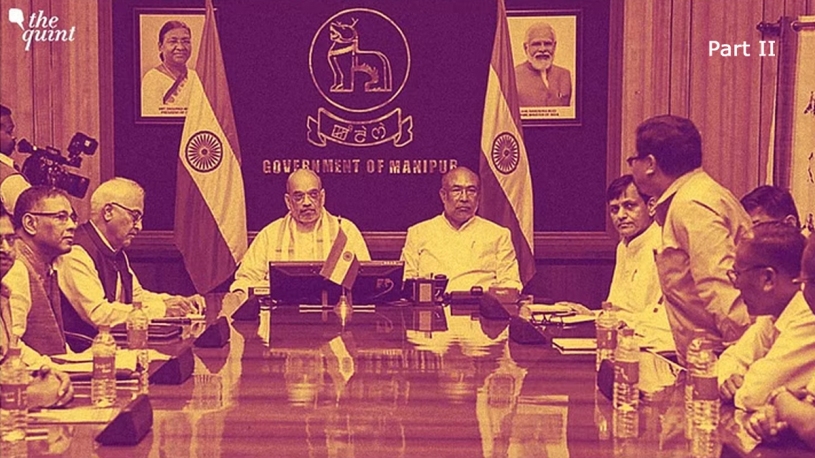[By Bhanu Dhamija]
Follow @bhanudhamija[A version of this article was published under the heading ‘Manipur Violence: A Decentralised Constitution May Be the Key to Democracy’ on The Quint website on 11 August 2023.]
Manipur continues to burn with ethnic violence. In my previous column I argued that our parliamentary system’s basic flaws—unfettered majority-rule, sectarian governments, fusion of legislative and executive powers, and a lack of checks and balances—have contributed to the ethnic violence being suffered by that state. These constitutional flaws make all Indian governments terribly authoritarian, unable to respond to the various needs of a diverse society.
Many of our founding fathers understood these flaws, and they suggested remedies. Vallabhbhai Patel, Bhimrao Ambedkar, and Mahatma Gandhi all offered visions for India’s constitutional structure to avoid just this problem of majoritarianism. But their ideas were ultimately ignored by the Constituent Assembly.
Founders Wished to Avoid Majoritarianism
Ambedkar’s suggested fix for unfettered majority rule was to restrain it by limiting its executive power. He wrote, “the British type of Executive will be full of menace to the life, liberty and pursuit of happiness of the minorities.”[1] His formula called for a government that was “non-Parliamentary in the sense that it shall not be removable before the term of the Legislature.” He wanted the chief executive (Prime Minister or Chief Minister) and all cabinet members from the majority to be elected by the whole house. Cabinet members from the minorities would be elected by their communities. By the time the Assembly began discussing Ambedkar’s proposal, however, he had been appointed Chairman of the Constitution’s Drafting Committee and agreed not to pursue his own ideas.
Patel’s idea for restraining the majority was to have a directly elected chief executive in each state (Governor) with some discretionary powers. His model Provincial Constitution was even approved by the Constituent Assembly. He touted the “the dignity of the office which a popular Governor will hold,” and wrote that “a Governor who has been elected by adult franchise of the whole province will exert considerable influence on the popular ministry.”[2]His arguments so influenced the scholars engaged in framing the Constitution that they concluded that even the President should be directly elected. They passed a resolution to this effect during a joint meeting of Patel’s Provincial and Nehru’s Union Constitution committees. But Nehru ignored their resolution, and the Assembly later reversed its approval of Patel’s framework.
“In my dreams of a model state, power will not be concentrated in a few hands. A centralized government becomes expensive, unwieldy, inefficient, corrupt, often ruthless, and is always heartless.”
— Mahatma Gandhi
Gandhi’s approach to avoiding majoritarianism was entirely different. He wanted India to have a decentralized constitutional structure with Panchayats at its core, running their own districts’ affairs. His thoughts were outlined in Gandhian Constitution of Free India (1946) by Shriman Narayan Agarwal, one of his associates and later Governor of Gujarat. The book described a “Decentralized Village Communism” with full autonomy at the local level in education, health, economy and administration. Gandhi had experimented with such a constitution for a decade in a princely state in Maharashtra.
“In my dreams of a model state,” Gandhi said, “power will not be concentrated in a few hands. A centralized government becomes expensive, unwieldy, inefficient, corrupt, often ruthless, and is always heartless.”[3] But Gandhi’s ideas were not included in the framing of the Constitution, which was adopted two years after his assassination.
Use Rajya Sabha and Bar Government from Religion
In addition to revisiting those excellent ideas of our Founders, India could also use the Rajya Sabha more effectively. Our Council of States, instead of representing the states, has become a council of political parties. I have argued before that its members should be directly elected by the entire state, and each state should be given equal representation.[4] A House so configured would be more effective at restraining majoritarian laws. It could also be used to oversee the appointments and functioning of the judiciary; the ED, CBI and other investigative agencies, and the Election Commission.
To end ruthless majoritarianism, the country also needs to restrict governments from engaging in religious activities. This “separation of Church and State” is fundamental for any diverse democracy. India could set up a Religious Council, giving all our religions equal representation and a say in religion-based laws.[5]
These changes–ending the majority’s control over ministries; giving Panchayats and local governments real independence; electing the President and Governors directly; using the second chamber of the legislature to check executive authority, and barring governments from religious activities—would improve our governance enormously
Nearly all these reforms are built-in features of the Presidential system practiced in the United States. India could, in a bold stroke, adopt a version of that system completely. Then we would enjoy the decentralized structure our Founders imagined, as well as the necessary separation of legislative and executive powers, and direct elections of our senior executives.
Either way, it’s time for India to end majoritarianism and prevent more devastating carnage like we’re seeing in Manipur.
(The author is Founder and CEO of the Divya Himachal group and author of ‘Why India Needs the Presidential System’. He can be reached @BhanuDhamija.)
[1]The Framing of India’s Constitution by B. Shiva Rao, Volume 2, pp. 84-104
[2]Constituent Assembly Debates, 15 July 1947
[3]https://presidentialsystem.org/2020/10/10/what-would-gandhi-think-of-our-constitution/
[4]https://presidentialsystem.org/2017/08/24/rajya-sabha-must-be-overhauled-or-lose-its-value-to-our-democracy/
[5]https://www.thequint.com/opinion/india-multiculture-diversity-america-vishwa-guru-secularism#read-more
